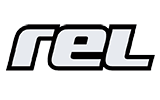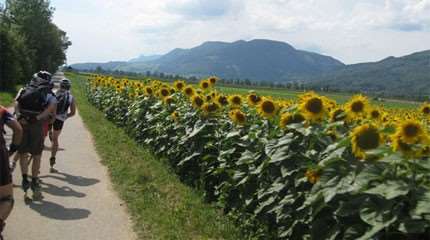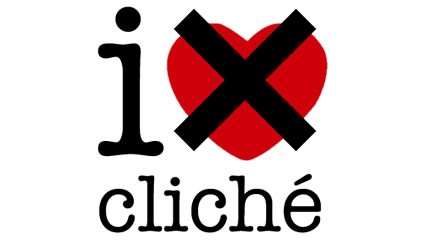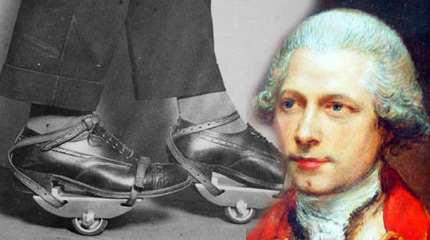How to Choose Your Skates?
Par Vernon SULLIVAN |
Publié le 19 February 2009 |
Mis à jour le 3 November 2020 |
Catégories :
All
All
| Sous-catégories :
how to choose your roller-skates and inline skates
how to choose your roller-skates and inline skates
| 407774
| Tags :
choice roller skate
inline skates
Kids
roller skates
choosing roller-skates
Esthetics set aside — being a very personal criterion —, choosing a pair of skates, inlines or quads, lies on many objective criteria, varying according to several parameters: type of practice, intensity of use, level of skating, budget. Online-Skating.com browses the key points that should help you make your choice…
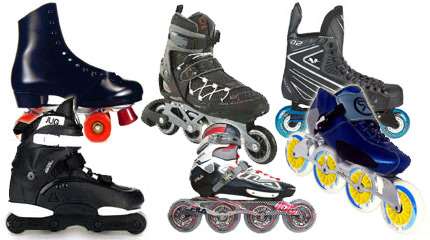
How to Choose Your Skates?
A pair of skates is often designed for a specific type of practice.
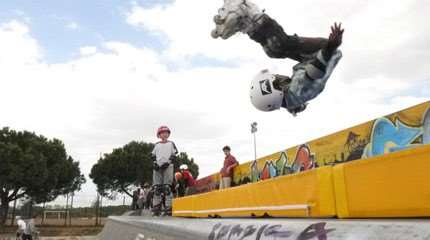 First of all, note that it’s hard to find a pair perfectly meeting the needs of several disciplines at once, since their characteristics may be totally opposite. If you’re looking for a versatile pair, go for freeride skates, they are suitable for the widest range of practices.
First of all, note that it’s hard to find a pair perfectly meeting the needs of several disciplines at once, since their characteristics may be totally opposite. If you’re looking for a versatile pair, go for freeride skates, they are suitable for the widest range of practices.
If You Can, Try Before Buying
If you are a beginner and/or if you are not sure that you will like skating, rent a pair for a weekend or borrow your friends’ to give it a try.
You will have a better idea whether you feel like skating some more. Don’t hesitate to have a go at several skating practices, there is always one that will suit you best!
Moreover, some shops refund their rental fees when you buy a pair.
What Budget If You Know You Like Skating?
Don’t rush right away on value-priced skates, which are often uncomfortable and reach their limits very fast. Low-end skates are the best way to put you off skating!
Rather opt for a mid-range pair, more comfortable and efficient, which will allow you to improve safely and with total peace of mind, without having to change or upgrade a few months later. You can get an idea of the wideness of the offer on our Skating Catalog (Warning: this is a skating database, not an online shop).
Advice: a “good” pair of skates to start with costs between €100 and €200. If you don’t have the budget, you can also buy second-hand skates.
What Will Be My Main Discipline?
If you intend to practice several skating disciplines but you have a limited budget, always go for the model that will suit the better to your main use. You won’t grow weary of skating. The more you vary your disciplines, the better your technical level gets!
Soft Boots or Hard Shells?
You will find lots of hard boots (or shells) amongst entry-level skates because they are less expensive to produce. They are often less comfortable than the “soft” ones, which allow to skate longer without pain. However, hard boots are better suited to some practices such as downhill, freeride, or slalom skating, for which the skater needs control and support.
Skating Boots/Shoes Sizes and Shapes
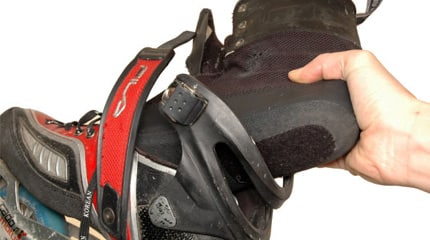 Each brand fits differently, as for length and width. Your shoe size is only an indicative basis. You should rely on your feelings.
Each brand fits differently, as for length and width. Your shoe size is only an indicative basis. You should rely on your feelings.
Also know that your feet will swell a bit during effort. It’s better to have a small margin at the toes.
According to brands, the shape of the shoe can also vary considerably. Don’t be surprised if one model of a particular brand feels tight, and another model of the same size but different brand doesn’t.
Advice: Keep the skates on for at least 15 minutes when you try them out, and move around in the skate shop.
For long distance skating, having skates that are slightly big isn’t a problem. On the other hand, if you practice a technical discipline, like slalom, hockey, or speed skating, it is better to have close-fitting skates for better precision and reactivity.
Which Skates to Choose for Kids?
For junior skates, the best solution remains to choose an adjustable model. The initial budget is a bit bigger, but the kid will keep the skates longer and will be more comfortable in them. If the skates are not adjustable, make sure you take skates that are one to two sizes bigger, with hard boots and a solid closure system. Hard shells offer good foot support, while compensating for the growth of the kid. You can also use an insole for more support, but avoid slipping on too many layers of socks, which will only result in a loss of sensations.
Further Reading: Choosing skates for your kids
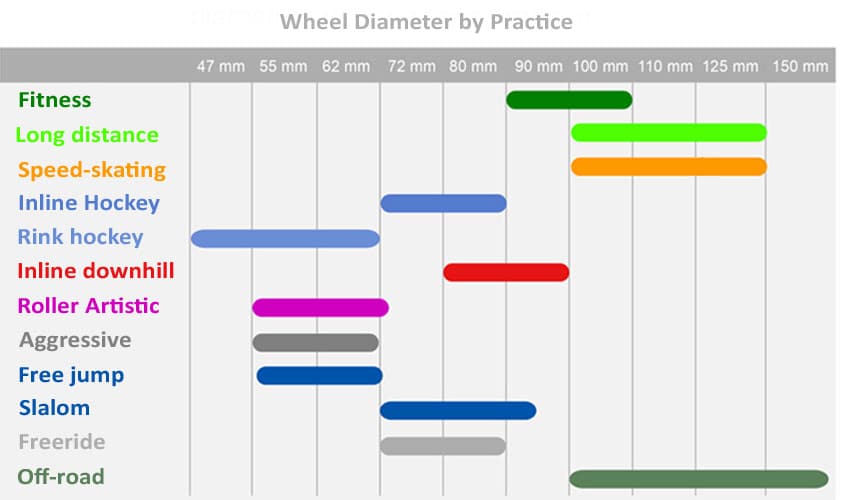
Recap: Technological Needs According to Skating Practices
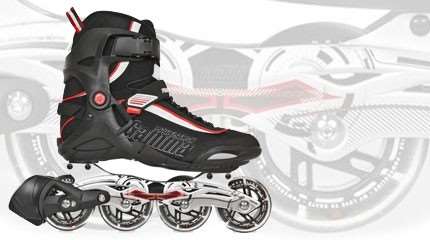
In order to better understand the technical terms used in the chart above, you can have a look at the tabs explaining the anatomy of a pair of inline skates.
Fitness Skates
Those skates should be comfy and light, to easily cover several kilometers, even several dozen kilometers.
Main Technical Characteristics
• Boot: Semisoft (often canvas + plastic shell)
• Wheels: Medium size (80 to 90 mm), and soft (78 to 82A)
• Frame: Composite or aluminum, medium size (260 to 300 mm)
• Bearings: ABEC 3 to 9
If You Feel That Fitness Skating Is Going To Be Your Main Sport
You may choose skates with wheels up to 100 mm: they will be higher, thus less stable to start with, but with time, they will offer better rolling and comfort on damaged grounds.
Further Reading: Choosing your Fitness Skates
Aggressive / Street / Ramp / Skatepark Skating
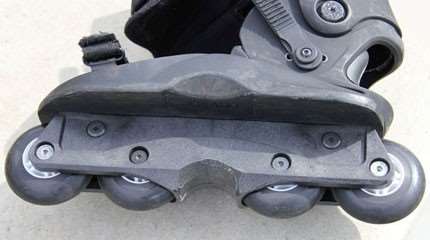 Aggressive skates are sturdy and enhanced to withstand the constraints related to shocks and friction on rails and walls. They also resist better to falls. They have notches on their frames and shells for stalling.
Aggressive skates are sturdy and enhanced to withstand the constraints related to shocks and friction on rails and walls. They also resist better to falls. They have notches on their frames and shells for stalling.
Main Technical Characteristics
• Boot: Hard (rarely semisoft, except for K2 skates)
• Wheels: Small (52 to 60 mm), and hard (88 to 100A)
• Frame: Flat (4 wheels touching the ground) or freestyle (2 wheels, one at each end) or with anti-rockers (2 small middle wheels and 2 bigger end wheels, not to get stuck on walls)
• H-block, groove, grind plate and soul plate
Types of Frames Vary According to Your Specialty
According to the aggressive specialty you turn to, frames are different:
• Flat set-up: 4 wheels touching the ground – for ramp or skatepark
• Freestyle set-up: 2 wheels at the ends
• Anti-rocker set-up: 2 small wheels in the middle, 2 bigger wheels at the ends – for skatepark
Further Reading:Well Choosing Your Aggressive Skate Frames (street, ramp, park…) and Choosing your aggressive skates for street, skate park and half-pipe
Speed/Race Skating
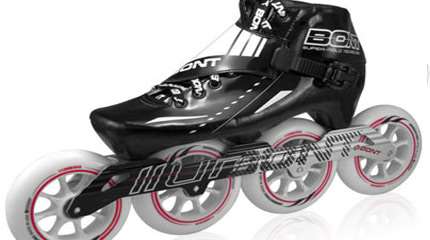 Speed skating models combine great rigidity for power transmission, and lightness for best efficiency, with big diameter wheels. In general, you only start speed skating once you’ve got the skating basics down. It is better to do fitness skating before getting this type of equipment.
Speed skating models combine great rigidity for power transmission, and lightness for best efficiency, with big diameter wheels. In general, you only start speed skating once you’ve got the skating basics down. It is better to do fitness skating before getting this type of equipment.
Main Technical Characteristics
• Boot: Low-cut, hard, made of carbon or composite, without liner
• Wheels: Big (100 to 125 mm), quite hard (82 to 90A)
• Frame: Long, made of aluminum or carbon, with 3 or 4 wheels of big diameter
• Bearings: Standard or micro-bearings, ABEC 5 and above
A Constant Technological Development
Speed skates used to be mounted on 5 wheels of 76 to 90 mm until around 2003. The most common set-ups nowadays are 4×100 mm and 4×110 mm. The 3×125 mm arrived on the marathon market in 2015. Speed skates for kids may have smaller wheels.
Further Reading: Choosing your speed skates and How to choose skates when you are a speed-skating beginner?
Endurance and Long Distance Skates
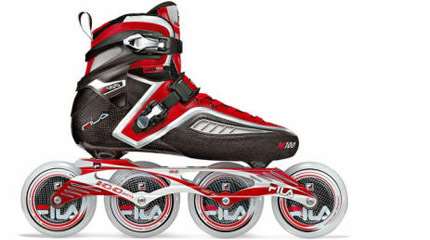 Close to fitness skates, endurance, raid and long distance skates often have bigger wheels to cover longer distances and compensate for bad quality grounds. Their boots are generally more rigid, lower, and lighter. They look more like speed skates, with extra comfort.
Close to fitness skates, endurance, raid and long distance skates often have bigger wheels to cover longer distances and compensate for bad quality grounds. Their boots are generally more rigid, lower, and lighter. They look more like speed skates, with extra comfort.
Main Technical Characteristics
• Boot: Semisoft, with carbon or composite basis, with liner
• Cut: Lower than that of a fitness skate, but higher than that of a speed skate (with a cuff)
• Frame: Aluminum or carbon, 3 or 4 wheels, quite long
• Wheels: Big wheels (90 to 125 mm), quite hard (82 to 86 A)
• Bearings: Standard or micro-bearings, ABEC 5 to 9
It is important that your feet are not too loose in your endurance skates, and that you don’t feel any pressure point.
Further Reading: Choosing your long distance skates and
How to choose your long rides roller-skates
Roller Inline Hockey
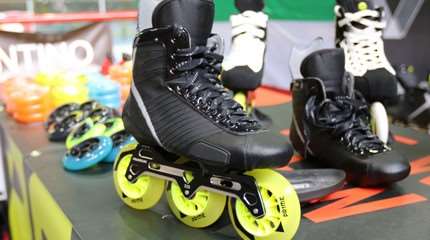 Hockey skates are compact and rigid for increased reactivity and precision. They withstand violent changes of direction, of speed, and sudden braking. They are put to a severe test all the time!
Hockey skates are compact and rigid for increased reactivity and precision. They withstand violent changes of direction, of speed, and sudden braking. They are put to a severe test all the time!
Main Technical Characteristics
• Boot: High-cut, rigid, made of composite (carbon, glass fiber)
• Closing: Laces only
• Frame: Short and rigid (aluminum)
• Wheels: 72 to 80 mm, hard or soft according to the field
A Developing (R)evolution
Since 2016, Reign, the new 100% Roller Hockey brand by Powerslide, has been innovating in launching on the market 3×100 mm hockey skates, a set-up offering more rolling on bigger fields.
Further Reading: How to choose your inline hockey skates?
Downhill Skating
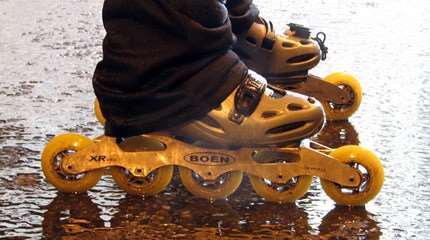 Models with 5 wheels and rigid shells have been the most common set-ups in downhill skating since the very beginnings of the discipline. The 5-wheel set-up is the best to negotiate a bend, control your braking, and for precision and support. Hard shells give the support and precision needed to take high speeds and emergency stops.
Models with 5 wheels and rigid shells have been the most common set-ups in downhill skating since the very beginnings of the discipline. The 5-wheel set-up is the best to negotiate a bend, control your braking, and for precision and support. Hard shells give the support and precision needed to take high speeds and emergency stops.
Main Technical Characteristics
• Shell: High-cut and rigid, made of hard plastic or composite
• Frame: Long, made of extruded aluminum, 5 or 6 wheels
• Wheels: Medium size (80 to 90 mm), quite hard (85 / 86A)
Very Little Production Models, Make Way to Customized Skates!
It is hard to find downhill production models on the market, except maybe with the Seba brand. Don’t hesitate to go to a specialized shop, or ask for the help of experienced skaters to make your own customized pair of downhill skates.
Further Reading: Inline downhill: where to find your skates and how to get it cheap
Artistic Skating on Wheels and Dance
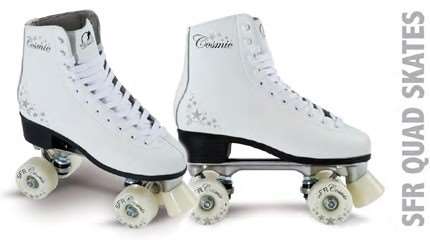 Quad skates still reign supreme over artistic skating and dancing because of the wide variety of steps and moves they allow, compared to inline skates (like edges, for example).
Quad skates still reign supreme over artistic skating and dancing because of the wide variety of steps and moves they allow, compared to inline skates (like edges, for example).
However, inline skates with toe stops may start taking more room on the market! Having a toe stopper is imperative to launch some particular jumps. Today, there are but very little inline models available. Most skaters use Picskates models, made in the USA.
Main Technical Characteristics
• Skates: Quad or Inline Skates
• Boot: High-cut, rigid, often made of leather
• Closing: 100% laces
• Toe Stoppers
• Trucks: Aluminum
• Wheels: 55 to 63 mm, hardness according to the type of floor from 78 to 94 A
Further Reading: Choosing your Artistic Skate wheels and Artistic Inline Skating: Which skates to use?
Jump
Quad skates have monopolized this practice for a long time, but now more and more skaters use freeride inline skates to jump. Quads are more stable when landing, but often heavier, thus harder to take off the ground.
Main Technical Characteristics
• Skates: Quad or Inline Skates, preferably with hard shell
• Frame: Aluminum, very rigid and solid
• Wheels: Soft to medium (78 to 85 A)
Slalom Skates
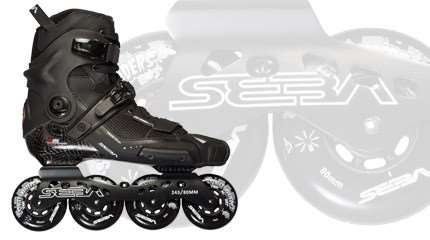 Slalom skates are rigid for more precision and control, with short frames for better maneuverability.
Slalom skates are rigid for more precision and control, with short frames for better maneuverability.
Warning: Within slalom skating, you should distinguish between freestyle slalom and speed slalom, which are two different specialties. More and more speed slalomers go for 3×100 or 3×110 mm frame set-ups.
Further Reading: Well choosing your slalom skates
Freestyle Slalom
• Boot: Rigid or semisoft
• Frame: Short, aluminum (231 to 243 mm)
• Wheels: 70 to 80 mm, rockered set-up, more or less hard according to the ground (78 to 85A)
Speed Slalom
• Boot: Rigid or semisoft
• Frame: Short, aluminum (243 to 247 mm)
• Wheels: 3 wheels of 100 to 110 mm (83 to 86A)
Further Reading: Choosing Your Slalom Skates
Freeride Skates
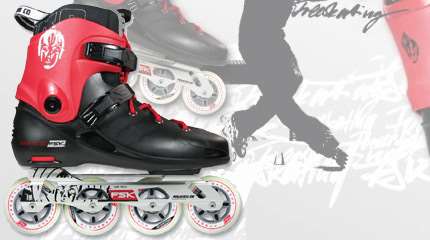
Halfway between aggressive and fitness skates, those skates have the resistance of an aggressive model and the wheel diameter of a fitness model to skate the city and do tricks at full speed. They are sometimes equipped with soulplates on the sides of the frames to stall on walls and rails.
Main Technical Characteristics
• Boot: Rigid, with wrapping cuff
• Frame: Short, aluminum (around 243 mm)
• Wheels: Medium size (76 to 84 mm), quite hard (82 to 86A)
• Side abrasive pads on the boot
Towards bigger diameters
More and more freeride models are set up with 3×100, 3×110, even 3×125 mm wheels! This type of set-up is more designed for speed than tricks. They are less maneuverable than 4×80 mm skates, but allow for quick and comfortable urban skating.
Further Reading: Choosing your freeride skates
All-Terrain Skates
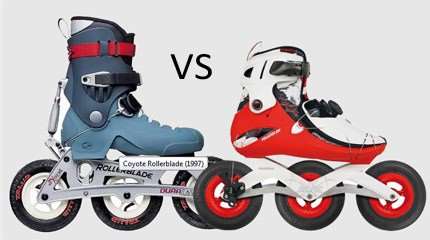 Very few models are available on the market. Back in the days, you could find second-hand Coyotes by Rollerblade, as well as Roces Big Cats.
Very few models are available on the market. Back in the days, you could find second-hand Coyotes by Rollerblade, as well as Roces Big Cats.
For a few years now, brands like Powerslide have taken up the torch with models such as the Powerslide Vi SUV. Other brands, like Trailskate, release skates of a different shape, which are closer to all-terrain wheeled skis, also called Nordic Skates.
Those models can also be used for kite skating.
Main Technical Characteristics
• Boot: Rigid, high upper for more support
• Wheels: Big tires (150 mm and over)
• Frames: 3 wheeled, oversized and strengthen, aluminum
• Bearings: “Waterproof”
Roller Derby Skates
 Roller derby skates look a lot like old quad speed skates. Some brands like Bont use their historical know-how in this field to meet the players’ demands.
Roller derby skates look a lot like old quad speed skates. Some brands like Bont use their historical know-how in this field to meet the players’ demands.
The skates are subjected to the same constraints as in speed skating or rink hockey, but also need a little extra enhancement. Like in rink hockey, players are constantly breaking their speed and changing directions.
Main Technical Characteristics
• Boot: Relatively low-cut, rigid, with good ankle support (leather or carbon)
• Plate: Aluminum, compact, with trucks tilted at an angle for more maneuverability
• Wheels: 59 to 62 mm, hardness 88 to 95A according to types of floors
• Toe stoppers: Quite short and adjustable in height
Rink Hockey Skates

Rink hockey is very demanding on quad skates: incessant starts, energetic brakes, constant changes of directions… They should protect ankles from ball shots and stick hits.
Main Technical Characteristics
• Skates: Compulsory quad skates
• Boot: Ankle-cut, rigid
• Toe Stopper: Short, allowing for reactive braking and fast starts
• Closing: 100% Laces
• Wheels: 62 or 63 mm, hardness from 88 to 97A
Further Reading: Anatomy of a Rink Hockey Boot
The Example of Fitness Skating
Frequency of Practice
It is important to determine the extent to which you skate, so that you can adapt your skates to your practice. Let’s take the example of fitness skating.
Note: Nothing prevents you from buying better quality equipment if you feel like treating yourself.
| Occasional Practice | Regular Practice | Intensive Practice |
|
1 to 2 times per month. Level: Beginner |
Once a week. Level: Advanced |
Several times a week. Level: Expert |
| Budget from €45 to €90 | Budget from €90 to €200 | Budget from €200 to €400 and more |
| Boot: Hard shell Frame: Composite or plastic Wheels: 80 mm (medium), 78 to 82A (soft) Bearings: ABEC 3 to 5 |
Boot: Semisoft Frame: Composite or aluminum Wheels: 80 to 90 mm, 78 to 82A (soft) Bearings: ABEC 5 to 7 |
Boot: Semisoft Frame: aluminum, long, 3 to 5 wheels Wheels: 80 to 125 mm, 82 to 88A (hard) Bearings: ABEC 5 and above |
Useful links
Choosing skates for your kids
What type of roller-skates will suits you ?
Buying second-hand skates
Translation: Chloe Seyres
Photos: all rights reserved
Auteur
Vernon SULLIVAN
''SULLIVAN''
Passionné de roulettes devant l'éternel, le jour j'écume le bitume. Si je me crashe, si je tombe, ma peau s'arrache mais pas mon coeur de roller !
Photographe
Alexandre Chartier
''alfathor''
Alexandre est le fondateur et webmaster de rollerenligne.com depuis 2003. C'est un passionné de roller en général, tant en patin traditionnel qu'en roller en ligne. Il aime le patinage à roulettes sous tous ses aspects : histoire, économie, sociologie, évolution technologique... Aspirine et/ou café recommandés si vous abordez un de ces sujets !
